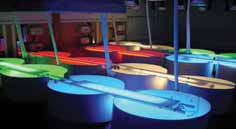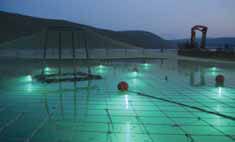These projects are run in collaboration with the Icelandic Fisheries Laboratories (IFL), the Institute of Marine Research in Norway (IMR) and a number of SMEs including Intravision Group AS (Norwegian lighting manufacturer) and Johnson Seafarms Ltd in Shetland. The projects started in 2006 and Stirling involvement is coordinated by the Reproduction Group (Dr Herve Migaud with support from Dr Andrew Davie and Dr John Taylor) in collaboration with the Aquatic Vaccine Unit (Dr Kim Thompson and Prof. Alexandra Adams).

The overall aims of these projects are to enhance the productivity of Atlantic cod farming by optimising techniques through the development and deployment of novel lighting technologies that are specifi c to both the sensitivities of the fi sh throughout the production cycle and the rearing systems used. This goal will be achieved through a combination of laboratory-based studies focusing on light perception in cod at the physiological and endocrinological level, in conjunction with proof of concept onfarm trials to demonstrate the effi cacy of the newly designed lighting systems.
Although part of the work is focusing on early stages (larvae, juveniles), the priority is on the control of maturation during the on growing stage as cod held in intensive culture mature within two years of hatching, resulting in a reduction of somatic growth rate, decrease of condition and deterioration of fl esh composition.

A delay or cessation of maturation during on-growing is therefore crucial for profitable farming. Seasonallychanging day length (photoperiod) is the natural time-keeping mechanism used by fi nfi sh from temperate latitudes to entrain a number of important physiological processes, including sexual maturation and overlaying of artifi cial illumination on the natural daynight cycle masks this seasonally changing signal.
Such techniques have been shown to successfully regulate maturation in a number of tank-based studies in Atlantic cod (Dr Andrew Davie PhD Thesis: http://hdl.handle. net/1893/109) in which a complete cessation of maturation and up to a subsequent 60% improvement in growth have been observed. When such test photoperiods are applied at a commercial scale in open floating cage systems, it is believed that ambient light can have a major regulatory influence and as such the results reported have not been consistently reproducible. The research focuses on the development of a new lighting technology based on cold cathode light tubes, and then appropriate lighting protocols for application in cod mariculture.
The specific objectives of these projects are therefore to:
- Develop new narrow bandwidth lamps and light systems for use during the cod production cycle that are effective in improving performances at the hatchery and delaying sexual maturation in seacages, easy to use in the fish farming environment and represent an energy efficient solution (collaboration with Intravision).
- Determine cod light sensitivity (intensity and spectrum) at key life stages using in vitro culture, micro-spectrophotometry and electrophysiological techniques (collaboration with IMR).
- Develop and validate a cod maturation detection kit (pregnancy test) allowing up to 4 month on-farm prediction of a spawning event (collaboration with Aquatic Diagnostics Ltd).
- Test and validate new lighting regimes (photoperiod management ) i n commercial on-growing and determine eff ects on survival, growth performance and maturation at various locations (with Johnson Seafarms Ltd).
The results from the project will deliver new tools, protocols and quality schemes that should enable the cod mariculture industry to improve their economic situation, whilst improving cod welfare.
Footnote
Published in Aquaculture News from the Institute of Aquaculture, University of Stirling.
January 2007

